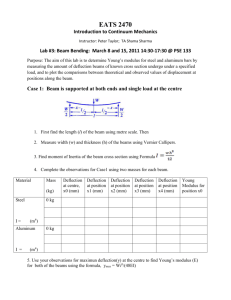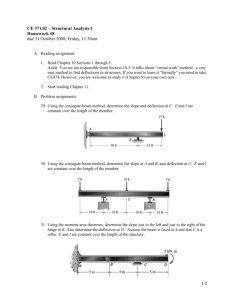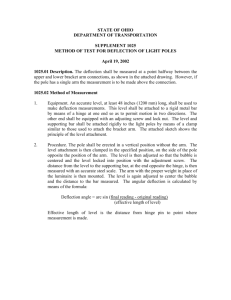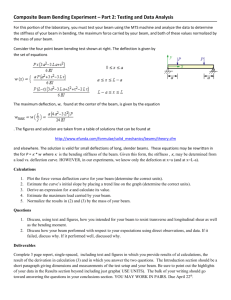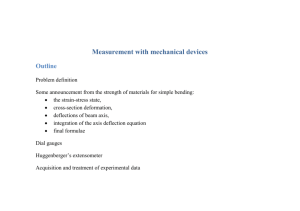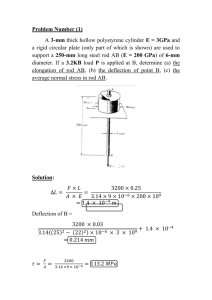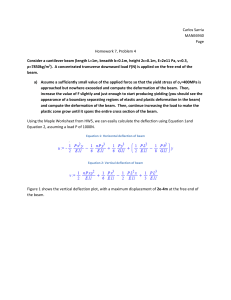Bending Beam - Louisiana State University
advertisement
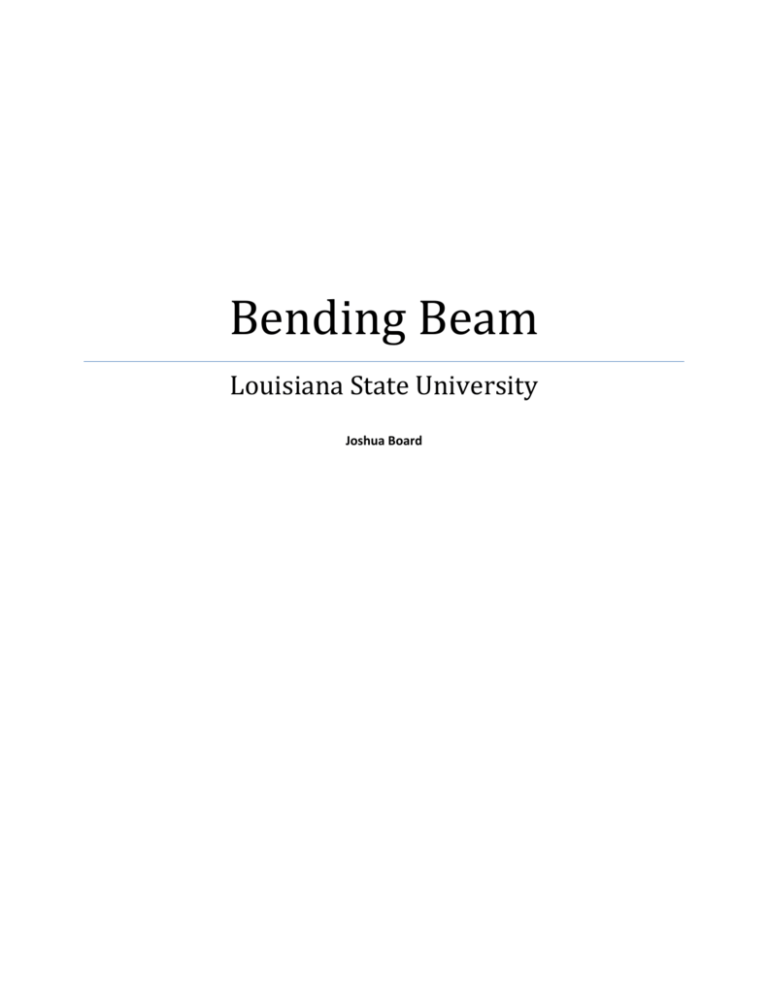
Bending Beam Louisiana State University Joshua Board Table of Contents: Table of Figures: ........................................................................................................................................... 4 Purpose.......................................................................................................................................................... 5 Introduction ................................................................................................................................................... 5 Apparatus and Test Procedures ................................................................................................................... 11 Summary of Data ........................................................................................................................................ 14 Discussion of Results .................................................................................................................................. 17 Conclusion .................................................................................................................................................. 20 References ................................................................................................................................................... 21 Sample Calculations.................................................................................................................................... 22 3 Table of Figures: Figure 1 - Bending on a Cross Section ........................................................................................................... 5 Figure 2 - Bending Action caused by Transverse Loads ................................................................................ 6 Figure 3 - SM104 Beam Apparatus ............................................................................................................. 11 Figure 4 - Loading Arrangement for Test 1 and Test 2 ............................................................................... 12 Figure 5 - Loading Arrangement for Test 3 ................................................................................................. 13 Figure 6 - Deflection vs. Load Theory.......................................................................................................... 18 Figure 7 - Deflection vs. Load Experimental ............................................................................................... 18 Figure 8 - Deflection vs. Load Steel Theory................................................................................................. 19 Figure 9 - Deflection vs. Load Steel Experimental ...................................................................................... 19 Table 1 - Test 1 Data ................................................................................................................................... 14 Table 2 - Test 2 Steel 6mm .......................................................................................................................... 15 Table 3 - Test 2 Steel 3mm .......................................................................................................................... 15 Table 4 - Test 2 Brass 6mm ......................................................................................................................... 15 Table 5 - Test 2 Aluminium 6mm ................................................................................................................ 16 Table 6 - Stiffness ........................................................................................................................................ 16 Table 7 - Test 3 Data ................................................................................................................................... 17 4 Purpose The purpose of this laboratory is to become familiar with the SM104 Beam Apparatus by first verifying its sensitivity and accuracy. The second part of the lab will focus on using the SM104 Beam Apparatus to determine the deflection of point-loaded simply-supported beams made of steel, brass or aluminum. Using the deflection measurements, an examination of the relationship between deflection and material properties will be shown along with a comparison of the materials based on their strengths and deflections, both theoretical and experimental. The last objective of this laboratory is to verify the theory of pure bending using the SM104 Beam Apparatus. Introduction Engineers use beams to support loads over a span length. These beams are structural members that are only loaded non-axially causing them to be subjected to bending. “A piece is said to be in bending if the forces act on a piece of material in such a way that they tend to induce compressive stresses over one part of a cross section of the piece and tensile stresses over the remaining part” (Ref. 1). This definition of bending is illustrated below in Figure 1. Figure 1 - Bending on a Cross Section 5 It can be seen from Figure 1 that the compressive force, C, and the tensile force, T, acting on the member are equal in magnitude because of equilibrium. Therefore, the compressive force and the tensile force form a force couple whose moment is equal to either the tensile force multiplied by the moment arm or the compressive force multiplied by the moment arm. The moment arm is denoted, e, in Figure 1. Figure 2 - Bending Action caused by Transverse Loads Figure 2, shown above, is an illustration of bending action in a beam acted upon by transverse loads. Bending may be accompanied by direct stress, transverse shear or torsional shear, however for convenience; bending stresses may be considered separately (Ref. 1). In order to separate the stresses it is assumed that the loads are applied in the following manner: loads act in a plane of symmetry, no twisting occurs, deflections are parallel to the plane of the loads, and no longitudinal forces are induced by the loads or by the supports (Ref. 1). A beam or part of a beam that is only acted on by the bending stresses is said to be in a condition of “pure bending.” However for many circumstances bending is accompany by transverse shear. The term “flexure” is used to refer to bending tests of beams subjected to transverse loading (Ref. 1). A visual illustration of the transverse shear and bending moment can 6 be seen in the shear and bending moment diagrams of the beam. It is important to note that in a symmetrical 2-point loading scenario, the center portion of the beam will be in a condition of pure bending as such the bending stresses may be considered separately. “Deflection” of a beam is the displacement of a point on the neutral surface of a beam from its original position under the action of applied loads (Ref. 1). Before the proportional limit of the material, the deflection, Δ, can be calculated using the moment of inertia, modulus of elasticity along with other section properties that will depend on the given situation imposed on the beam. The position of the load, the type of load applied on the beam, and the length of beam are examples of section properties that depend on the situation. The deflection equations for two common cases are listed below in equations (1) and (2). Case 1: Center deflection of a simple beam with freely supported ends and concentrated load, P, at the mid-span (Ref. 1). Equation (1) where: Δ = deflection, (mm) P = load, (N) L = length of beam, (mm) E = modulus of elasticity (N/m2) I = moment of inertia of section about the neutral axis, (mm4) 7 Case 2: Center deflection of a simple beam with concentrated loads, each equal to P, at third points of span (Ref. 1). Equation (2) where: Δ = deflection, (mm) P = load, (N) L = length of beam, (mm) E = modulus of elasticity (N/m2) I = moment of inertia of section about the neutral axis, (mm4) Deflection is a measure of overall stiffness of a given beam and can be seen to be a function of the stiffness of the material and proportions of the piece (Ref. 1). Deflection measurements give the engineer a way to calculate the modulus of elasticity for a material in flexure. The stiffness of a given material is calculated using the following equation: Equation (3) where: P = load, (N) Δ = deflection, (mm) Stiffness (N/m) 8 A beam may fail in any of the following ways: A beam may fail by yielding of extreme fibers, in long span beams compression fivers act like those of a column and fail by buckling, in webbed members excessive shear stress may occur and stress concentrations may build up in parts of beam adjacent to bearing blocks (Ref. 1). The scope and applicability of the bending tests are defined as: 1) Used as a direct means of evaluation behavior under bending loads, particularly for determining limits of structural stability of beams of various shapes and sizes. 2) Made to determine strength and stiffness in bending. 3) Occasionally made to get stress distribution in a flexural member. 4) May be used to determine resilience and toughness of materials in bending. 5) Uses simple and inexpensive apparatus. 6) Used as control test for brittle materials and not suitable for determining ultimate strength of ductile materials. (Ref. 1) Deflection for experiment 1 is calculated with the following: Equation (4) where: R1 = reaction at support 1, (N) R2 = reaction at support 2, (N) W1 = load at point 1, (N) W2 = load at point 2, (N) 9 Percent error for experiment 1 is calculated with the following: Equation (5) where: Δ = deflection, (mm) W1 = load at point 1, (N) W2 = load at point 2, (N) For experiment 3, y is calculated as follows: Equation (6) where: h1 = reading from gauge 1, (mm) h3 = reading from gauge 3, (mm) For experiment 3, h is calculated as follows: Equation (7) where: h2 = reading from gauge 2, (mm) 10 Apparatus and Test Procedures In this laboratory, an SM104 Beam Apparatus was utilized and is shown below in Figure (3). This apparatus has load cells with a capacity of 0 – 46 N. Figure 3 - SM104 Beam Apparatus Procedure for Test 1: 1) Calibrate the dial gauges. 2) Find the mid span of the beam. 3) Set up load cells as shown in Figure 4. 4) Place a beam on apparatus with 1/4 span overhang. 5) Position the two hangers equidistant from the mid-point. 6) Position the dial gauge at the mid-point. 7) Apply the load to the hangers. 8) Record the data. 11 Figure 4 - Loading Arrangement for Test 1 and Test 2 Procedure for Test 2: 1) Calibrate the dial gauges. 2) Find the mid span of the beam. 3) Set up load cells as shown in Figure 4. 4) Place a beam on apparatus with 1/4 span overhang. 5) Place the hanger at the mid-span. 6) Position the dial gauge over the mid-span. 7) Apply the load to the hanger. 8) Record beam deflection. 9) Increase the load and record the dial reading, repeat for 5 different load patterns. 10) Decrease the load and record the dial reading, repeat for 5 different load patterns. 11) Repeat for each beam. Procedure for Test 3: 1) Calibrate the dial gauges. 2) Find the mid span of the beam. 3) Set up load cells as shown in Figure 4. 12 4) Place a beam on apparatus with 1/4 span overhang. 5) Place one hanger near the left end of the beam and place a second hanger near the right end of the beam as shown in Figure 5. 6) Position a dial gauge at mid-span and two other dial gauges equidistant on either side as shown in Figure 5. 7) Zero the gauges. 8) Apply the load to the two hangers. 9) Increase the load and repeat step 8 for at least five different loads. 10) Record the data. Figure 5 - Loading Arrangement for Test 3 13 Summary of Data The results from Test 1, the verification of the sensitivity and accuracy of the apparatus, are shown below in Table 1. This table shows the reactions at the supports based on the applied load. Deflection was calculated using Equation (4) and the percent error was determined with Equation (5). The average error for Test 1 is also shown in Table 1 and it was determined that the average error for this Test is 2.5%, therefore the SM104 Beam Apparatus is accurate within 2.5%. Table 1 - Test 1 Data R1 (N) 4.0 7.0 10.5 14.0 21.0 1.5 3.1 5.1 6.2 11.0 5.5 9.8 15.0 21.7 30.5 W1 (N) 5.0 10.0 15.0 20.0 30.0 0.0 0.0 0.0 0.0 0.0 5.0 10.0 15.0 20.0 30.0 W2 (N) 0.0 0.0 0.0 0.0 0.0 5.0 10.0 15.0 20.0 30.0 5.0 10.0 15.0 20.0 30.0 R2 (N) R1 + R2 (N) Δ (N) 1.2 5.2 3.3 10.3 5.0 15.5 6.0 20.0 8.0 29.0 3.8 5.3 6.9 10.0 10.5 15.6 14.7 20.9 20.2 31.2 5.1 10.6 10.2 20.0 15.2 30.2 19.7 41.4 30.8 61.3 Average Error % 0.2 0.3 0.5 0.0 -1.0 0.3 0.0 0.6 0.9 1.2 0.6 0.0 0.2 1.4 1.3 4.0 3.0 3.3 0.0 -3.3 6.0 0.0 4.0 4.5 4.0 6.0 0.0 0.7 3.5 2.2 2.5 14 The results for Test 2, deflection of a simply supported beam with load, beam thickness and material, are shown below based on material type in Tables 2 – 5. Each table shows the load applied, the material properties and both the theoretical and experimental deflections determined by Test 2. Looking at the tables it is clear that the material with the smallest cross section, 3mm Steel, experienced the largest deflection which was expected because that specimen has the smallest moment of inertia. Table 2 - Test 2 Steel 6mm Load (N) Steel (6mm) E (N/mm2) deflection theory (mm) deflection theory (m) 0 0 5 10 15 20 25 30 3.56849 7.13698 10.70547 14.27397 17.84246 21.41095 0 210000 Load (N) deflection exp (mm) deflection exp (m) 0 0 0.00357 Inertia (mm4) 0.00714 342 0.01071 Length (mm) 0.01427 1350 0.01784 0.02141 5 10 15 20 25 30 5 8 10 15 20 25 0.005 0.008 0.01 0.015 0.02 0.025 Table 3 - Test 2 Steel 3mm Load (N) Steel (3mm) E (N/mm2) deflection theory (mm) deflection theory (m) 0 0 5 10 15 20 25 30 28.54793 57.09586 85.64380 114.19173 142.73966 171.28759 0 210000 0.02855 Inertia (mm4) 0.05710 42.75 0.08564 Length (mm) 0.11419 1350 0.14274 0.17129 Load (N) deflection exp (mm) deflection exp (m) 0 0 0 5 10 15 20 25 30 30 70 100 130 170 200 0.03 0.07 0.1 0.13 0.17 0.2 Table 4 - Test 2 Brass 6mm Load (N) Brass (6mm) E (N/mm2) deflection theory (mm) deflection theory (m) 0 0 5 10 15 20 25 30 7.13698 14.27397 21.41095 28.54793 35.68492 42.82190 0 105000 0.00714 Inertia (mm4) 0.01427 342 0.02141 Length (mm) 0.02855 1350 0.03568 0.04282 Load (N) deflection exp (mm) deflection exp (m) 0 0 0 5 10 15 20 25 30 8 15 23 31 38 44 0.008 0.015 0.023 0.031 0.038 0.044 15 Table 5 - Test 2 Aluminium 6mm Load (N) Aluminium (6mm) E (N/mm2) deflection theory (mm) deflection theory (m) 0 0 2 4 6 8 10 3.94412 7.88824 11.83237 15.77649 19.72061 0 76000 0.00394 Inertia (mm4) 0.00789 342 0.01183 Length (mm) 0.01578 1350 0.01972 Load (N) deflection exp (mm) deflection exp (m) 0 0 0 2 4 6 8 10 3 7 11 16 21 0.003 0.007 0.011 0.016 0.021 Using the applied load and having already solved for the deflection of each material under that load, the stiffness of the material can be determined using Equation (3). Shown below is Table 6 which had the calculated stiffness for each material. Table 6 - Stiffness Material Thickness (mm) Stiffness (N/m) (theory) Stiffness (N/m) (exp) Steel 6 0.0007 0.0008 Steel 3 0.0057 0.0067 Brass 6 0.0014 0.0015 Aluminium 6 0.002 0.0023 The results from Test 3 are shown in Table 7 below. The table contains the applied load, the distances to the load, a and b, the dial gauge readings and the modulus of elasticity based on the data. The average E value is 108544.22 N/mm2 and after accounting for the error found in Test 1 our value is 105830.61 N/mm2. 16 Table 7 - Test 3 Data Test 1 Load (N) b (mm) a (mm) h1 (mm) h2 (mm) h3 (mm) y (mm) h2 - y 5 300 100 2.2 2.4 2.2 2.2 0.2 10 300 100 3.2 3.6 3.3 3.25 0.35 15 300 100 3.7 4.4 3.8 3.75 0.65 20 300 100 7.5 8.3 7.4 7.45 0.85 25 300 100 7.8 8.8 7.9 7.85 0.95 E (N/mm2) 109649.12 125313.28 101214.57 103199.17 115420.13 Test 2 5 10 15 20 25 300 300 300 300 300 150 150 150 150 150 1.7 3.5 4.6 6 6.8 2.2 4.4 6 7.8 9.2 1.8 3.4 4.6 6.2 6.8 1.75 3.45 4.6 6.1 6.8 0.45 0.95 1.4 1.7 2.4 109649.12 103878.12 105733.08 116099.07 102796.05 Test 3 5 10 15 20 25 300 300 300 300 300 200 200 200 200 200 1.4 2.8 5 4.7 4.6 2.2 4.5 7.6 8 8.5 1.3 2.9 5.2 4.8 4.6 1.35 2.85 5.1 4.75 4.6 0.85 1.65 2.5 3.25 3.9 103199.17 106326.42 105263.16 107962.21 112460.64 Inertia (mm4) 342 Average E value Average E accounting for error 108544.22 105830.61 Discussion of Results Test 1 showed that the SM104 Beam Apparatus was verified to have an average error of 2.5%. This is an acceptable error for this kind of test and we accounted for this error when we found the average E value in Test 3. Shown below in Figure s 6 - 9 are the graphs that were obtained from Test 2. Figure 6 shows deflection vs. load based on theoretical data and Figure 7 shows deflection vs. load for the experimental data gathered in the lab. From these charts it is clear to see that as the modulus of elasticity decreased from material to material, the deflection increased for the same applied load. This was true for both the theoretical and the experimental data. 17 Deflection vs. Load Theory 180 160 140 Deflection 120 100 6 mm Steel 80 3 mm Steel 60 6 mm Brass 40 6 mm Aluminum 20 0 0 5 10 15 20 25 30 35 Load (N) Figure 6 - Deflection vs. Load Theory Deflection vs. Load Experimental 250 Deflection 200 150 6 mm Steel 3 mm Steel 100 6 mm Brass 6 mm Aluminium 50 0 0 10 20 30 40 Load (N) Figure 7 - Deflection vs. Load Experimental 18 Figure 8 and Figure 9 both compare the two types of steels tested. From the figures, you can see that as the moment of inertia decreases, the deflection of the material increases. Deflection Deflection vs. Load Steel Theory 180 160 140 120 100 80 60 40 20 0 6 mm Steel 3 mm Steel 0 5 10 15 20 25 30 35 Load (N) Figure 8 - Deflection vs. Load Steel Theory Deflection vs. Load Steel Experimental 250 Deflection 200 150 100 6 mm Steel 3 mm Steel 50 0 0 5 10 15 20 25 30 35 Load (N) Figure 9 - Deflection vs. Load Steel Experimental 19 Table 7 displayed previously shows the results from Test 3. From the measured radius of curvature and the set up shown in Figure 5, the modulus of elasticity was determined. Even though some of the numbers that were determined were off by some error, the overall average value of E was determined to be 108,544.22 N/mm2. This number is very close to the expected value of 105000 N/mm2 and after accounting for the 2.5% error our numbers are very close. Conclusion Using the SM104 Beam Apparatus, we were able to determine first that our numbers were accurate. Secondly, we found from Test 2 that as the modulus of elasticity of each specimen decreased, the deflection increased which is consistent with Equation (1). We also determined that the stiffness of a material is a function of the load over the deflection, meaning that if the load increases but the deflection does not, then the material is considered stiff. Test 3 proved that the theory of pure bending holds true when the material has not exceeded the proportional limit because as shown in Table 7, the modulus of elasticity is constant over this region. Some human error could have occurred during the laboratory, however our results match up to the reference values which leads me to believe that error could not have played a big factor in this lab. Overall a greater understanding of deflection and how different materials react to the same applied load was achieved. 20 References 1. Jacobs, C., CE 3410 Notes – “Bending summary”, received in class on March 16, 2009. 21 Sample Calculations Steel 6mm Test 1: Deflection, Δ Δ = (4.0 + 1.2) – (5 + 0) = 0.2 % error = 4.0% Test 2: Deflection theory (mm) = 3.57 mm Stiffness (N/m) = 0.008 N/m Test 3: E= = = 7.97 x 1011 N/m2 22

